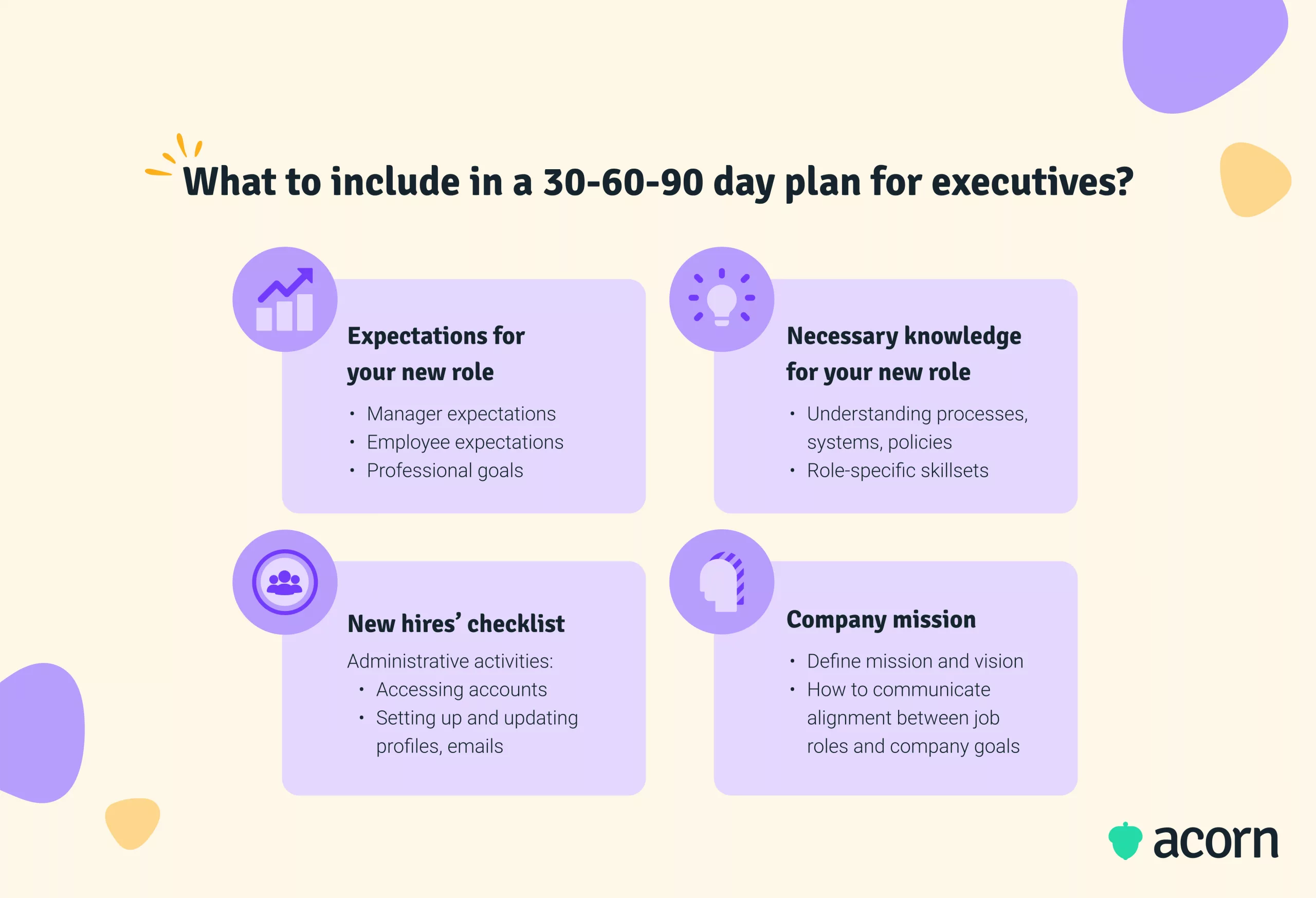Everything You Need to Know About the 30-60-90 Day Plan for Executives
Reading Time:

Lead the pack with the latest in strategic L&D every month— straight to your inbox.
SubscribeNew executives have a nerve-wracking task ahead of them: making an impact in their first few months.
Understanding the ins and outs can be difficult in that time. Even more so for executives, who have responsibility over employees and teams. It’s useful to have a structure in place to make the transition into a new position smoother both for the new executive and the employees working under them.
A 30-60-90 day plan can define this structure for the first three months of your role. In this article, we’ll dive into everything you need to know about creating a 30-60-90 day plan for executives in your organisation.
What is a 30-60-90 day plan?
A 30-60-90 day plan outlines objectives for the first three months of a new role:
- 30 days: Learn the organization
- 60 days: Contribute meaningfully
- 90 days: Lead with confidence.
For executives, a 30-60-90 day plan is less about ticking off onboarding tasks and more about accelerating trust and aligning leadership with the company’s mission.
Why is a 30-60-90 day plan for executives important?
Onboarding into an executive role is high stakes. You’re not just learning systems or processes; you’re stepping into a role that shapes strategy, culture, and performance. This is to say: Taking on a new job is overwhelming at the best of times. Couple that with taking on a new executive role, and you could be overloaded from all directions.
Executives often face information overload: understanding new teams, absorbing business models, and navigating stakeholder expectations, all while needing to demonstrate early wins. A 30-60-90 day plan cuts through that noise.
It’s important because it:
- Gives new executives structure in an otherwise overwhelming period
- Signals to employees and stakeholders that leadership has a plan and can be trusted
- Helps executives prioritize relationship-building alongside strategy execution
- Breaks down leadership goals into stages so development isn’t overwhelming
- Ensures training and capability-building are embedded from the start.
Ultimately, executives only get one “first impression” window. A 30-60-90 day plan makes that impression count by setting the tone for leadership, engagement, and performance.
We’ve seen that the most effective executive onboarding isn’t about checking boxes or generic leadership training. It’s about aligning new leaders to the capabilities their roles demand from day one—and giving them the tools to build those capabilities in practice. That’s exactly why we developed the performance learning management system (PLMS): to give everyone a development plan from day one.
What are the benefits of a 30-60-90 day plan for executives?
A well-structured plan benefits both the executive and the business. Key outcomes include:
- Maximized value and impact. A plan guides executives to align their work with the company’s mission early, driving engagement and productivity.
- Clear expectations. Executives know what is expected of them, and employees know what to expect in return. That clarity builds trust on both sides.
- Defined goal setting. With expectations in place, executives can establish measurable leadership goals and milestones.
- Improved productivity. Executives who know what to do, when to do it, and how success will be measured reach performance quicker and hit early wins.
In practice, all of these benefits come back to one thing: executives knowing what capabilities they need to succeed from their first day on the job.
What should be included in a 30-60-90 day plan?
Executive plans differ from those made for new managers or frontline employees. They have to account for broader responsibilities, greater complexity, and leadership visibility. There are four critical elements:
- Expectations and goals
- Resources and information
- New hires’ checklist
- Company mission.

Expectations and goals
Expectations are needed to define the basis of working relationships and your performance. This isn’t just about a leader’s expectations for their teams, but also the team’s expectations for their leader. The idea is for everyone to outline their expectations for their professional relationship to ensure the transition into their new working relationship is as smooth as possible.
Goals should be dual-layered: what the organization expects the executive to deliver, and what the executive wants to accomplish personally. Together, they form a roadmap for the first 90 days.
Resources and information
Executives can’t lead effectively without knowing the systems, processes, and organizational context they’re operating in. A 30-60-90 day plan should package the most important resources into one place—from policies and reporting structures to role-specific knowledge—so executives aren’t left piecing it together ad hoc.
New hires’ checklist
Even senior hires need the basics covered. From system logins to introductions with key stakeholders, administrative details can slow down early impact if they’re left unmanaged. A plan ensures these are captured and ticked off quickly, keeping executives focused on higher-value work.
Company mission
Perhaps most critical: executives need to understand how their role connects to organizational strategy and purpose. That alignment means they’ll also find value in what they do early on in their tenure, increasing their performance (and that of their team). You don’t need a 30-60-90 day plan to communicate this alignment between a role and organizational goals, but having one is a much more efficient and effective way of ensuring a new hire understands their greater purpose within the business.
Best practices when making a 30-60-90 day plan
When you go about creating a 30-60-90 day plan, there are a few best practices to keep in mind:
- Using SMART goals
- Breaking the plan down month-by-month
- Reviewing and monitoring.
Use SMART goals
SMART is a goal-setting model designed to help leaders set and meet business goals that are:
- Specific. Clearly define the goal so it’s tangible and easy to measure. For example, instead of “close more sales,” state “increase sales by 20% this quarter.”
- Measurable. Use KPIs or key metrics to track progress. With a goal like increasing sales by 20%, you know exactly how you’ll measure success.
- Attainable. Goals must be realistic within your resources. It’s pointless to aim for a big sales jump if you don’t have enough sales reps or developers to support demand.
- Relevant. Goals should align with long-term business strategy. If your focus is customer value, a goal like “push for aggressive upselling” won’t fit. Instead, design goals that balance revenue with customer experience.
- Time-bound. Define a reasonable timeframe. Too short, and you create stress and burnout; too long, and you risk complacency. Deadlines should push progress without setting executives up for failure.
The model ensures clarity, avoids vagueness, and makes goals motivational rather than overwhelming.
Break it down into separate months
It’s overwhelming to look at a plan that details everything a company and its senior executives want from you within your first three months. Breaking the plan into stages makes it more digestible and, therefore, more likely to be achieved.
First month, 1 – 30 days
Learn, listen, build relationships, and find gaps where you can have quick wins. Focus on understanding teams and setting expectations. You can do this with weekly meetings or one-on-ones with your team members to get a feel for who they are. (And don’t forget to gain a clear understanding of their expectations of you in these early meetings.)
Second month, 31 – 60 days
Begin contributing. Implement quick wins, drive small process changes, and start showing impact by ticking off those quick wins.
Third month, 61 – 90 days
The point at which you’re aiming to lead with confidence. Align teams with strategy, set long-term goals, and demonstrate leadership credibility.
Adjust accordingly, and follow up
No plan survives first contact unchanged. You have to account for some level of flexibility and be willing to adapt. Review the plan with your boss and team, measure progress on those SMART goals, and adjust where needed. And don’t stop there—use the plan as a springboard for the next quarter’s goals.
When to use a 30-60-90 day plan
There are two key moments when a 30-60-90 day plan comes into play:
- During the interview process
- During the onboarding process.
During the interview process
A 30-60-90 day plan can be a powerful tool in executive hiring. Hiring managers sometimes ask candidates to outline their first 90 days to gauge their strategic thinking, priorities, and leadership style. Even when it isn’t requested, candidates who bring one to the table show hunger and initiative to lead from day one.
For employers, this provides a window into how an executive sees the business:
- Do they understand the organization’s pain points and goals?
- Are they prioritizing people, processes, or results first?
- Can they balance quick wins with long-term capability building?
For candidates, it’s equally valuable. A proposed 30-60-90 day plan shows you’ve thought carefully about what value you can provide in helping them achieve their business goals—helping you stand out in a competitive field.
During the onboarding process
Onboarding is obviously the most common—and most impactful—time to use a 30-60-90 day plan. Here, the plan becomes a shared roadmap between employer and executive. It sets expectations on both sides for what:
- The organization believes success looks like
- The executive sees as personal goals and priorities
- Progress looks like against a structured framework.
For executives, this means they aren’t left guessing about what matters most in those critical early months. For employers, it ensures alignment, reduces ramp-up time, and makes performance measurable from the start.
Key takeaways
A 30-60-90 day plan is a useful tool for both the interviewing and onboarding processes, making a new executive’s transition into their role easier for themselves and their employees. Using a 30-60-90 day plan helps to maximise value, define clear goals and expectations, and optimise productivity in your organisation.
When you develop your plan, remember to:
- Use SMART goals
- Break it down month-to-month
- Monitor and review.